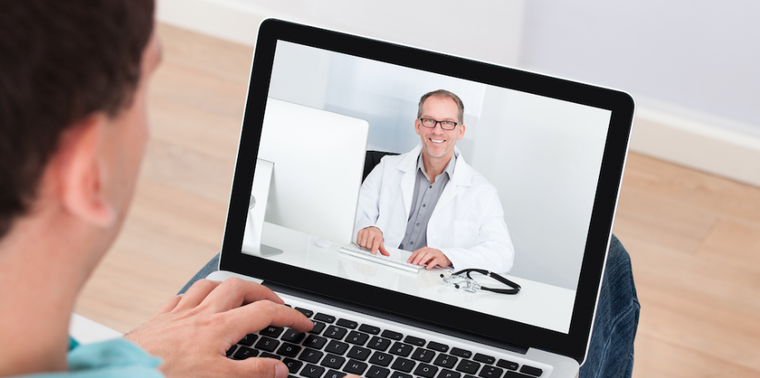
It’s on everyone’s minds — the novel coronavirus, which quickly evolved from a news story to a global pandemic. Countries are closing their borders. Cities are shutting down. Companies are telling employees to work from home. People are practicing social distancing. And the healthcare industry is experiencing unprecedented strain.
Today, the digital tools once used by physicians and hospitals for their convenience properties have become lifesaving prevention measures to slow the spread of COVID-19.
Many physicians are closing their offices temporarily to limit face-to-face contact and slow the spread of COVID-19. Others are adjusting their hours to accommodate patient demand. Even more are turning to FaceTime, Zoom, Google Hangouts, and other audio and video technologies to treat patients.
However you’re adjusting to COVID-19, make sure patients know what measures you’re putting in place. Update your listings across the healthcare web so patients don’t find conflicting or incorrect information. Consider adding banners and important messaging to your web profiles on sites like Healthgrades to redirect patients to special announcements, updated accessibility information, hotline numbers, and more crucial information.
Some tips to get started:
In times of crisis, physicians may be less concerned about their online reputations, turning their focus wholly to the responsibility of caring for patients. But reviews can shed light into performance issues that may require addressing — especially points of communication failure. Frustrated patients having difficulty getting in contact with the front office may resort to reviews as a way of getting heard. Other issues like appointment availability, overtaxed healthcare professionals, or ill-prepared waiting rooms may arise. You can even test-drive tools that do sentiment analysis to take the pulse of what’s happening outside of your purview.
Some third-party sites are tightening the reins on reviews during this pandemic. Google has suspended leaving and replying to reviews, and Yelp has put stricter content guidelines in place to limit the spread of misinformation. These new rules mean healthcare sites, like Healthgrades and Vitals, will see a spike in traffic, as patients search for trustworthy advice. Encourage patient reviews on these sites from patients’ own devices. If you are a current Doctor.com client, reach out to your customer success manager and ask about ReviewRequest — a fully digital method of collecting and publishing patient reviews, no shared surfaces involved.
Digital scheduling capabilities make it easier for patients to book appointments with you on their own time. They also free up your front office for more critical tasks — like screening patients, sterilizing the waiting room, or managing an influx of in-office demands.
Make sure all locations and physicians keep their office hours up to date. Adjust your appointment availability to reflect any changes, including expanded or reduced business hours, virtual appointments, and walk-in visits. If you’ve decided to temporarily stop seeing patients for the foreseeable future, use the vacation settings to block out the time you won’t be accepting appointments.
The Office of Civil Rights (OCR) at the Department of Health and Human Services announced that it is relaxing penalties for HIPAA violations to let doctors conduct virtual visits via audio and video technologies. This is a critical step for practicing “social distancing,” restricting the need for interactions, and curbing the spread of this virus (and others). If you decide a patient requires an in-person examination, telemedicine saves otherwise healthy patients — as well as physicians and their team members — from exposure.
Panic and chaos seem to be the ruling order of the day. In a time of crisis, however, the need for humanity and understanding is never more apparent. People are desperate for information. They are looking for leaders to assuage their fears, calm their nerves, and help them get through this trying time. So, don’t forget to show the human side of your practice.
Steps physicians can take to communicate on a personal level:
At Doctor.com, we know that the healthcare community is working around the clock to get us over to the other side of COVID-19. And we would like to thank the incredible doctors, nurses, and other medical professionals who are on the front lines of caring for the people who need it most. Because of you, there will be an end to this crisis.
If you have any questions about the steps and strategies outlined above, please do not hesitate to reach out. Current Doctor.com clients should contact their client success managers. Otherwise, please get in touch here if you think we can assist in any way.
Mara Kaufman, Chief Customer Officer
The original version of this page was published at: https://www.doctor.com/blog/digital-preparedness-covid-19
Doctor.com, a Press Ganey solution, empowers healthcare organizations to deliver better CX at every step of the patient journey. We provide the critical infrastructure and integrations necessary to... Read more
Doctor.com is joining the fight against the coronavirus pandemic. We want to do our part in supporting the physician community to continue to practice and treat patients during these ...read more
Dr. Hugh Melnick is an infertility specialist with over 30 years of experience under his belt. A longtime fixture in the field, he opened one of the first freestanding fertility clinics ...read more
Third-party sources of truth are a way of life for today’s savvy consumer. Like it or not, people have more agency in how they make decisions, turning to the web to search for ...read more
A doctor’s office is a busy place. A successful doctor’s office is even busier! And it’s not just in the examination room where things can feel hectic. Employees ...read more